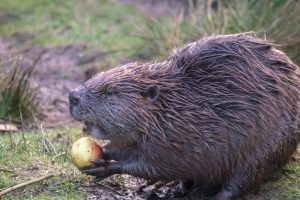Beavers!

A ball of fluff and a scaly tail sticking out the back. Sound like a toy or a new fashion trend? Well, it is actually a Beaver. These nocturnal 2nd largest members of the Rodent family are fascinating creatures and have had a surprisingly long history.
There are 2 main types of Beaver, the American Beaver, and the Eurasian Beaver. The Eurasian Beaver is slightly larger and has much thinner and lighter fur than their American relatives. Their tails are also less oval shaped and their heads are less round and have longer snouts. An odd little fun fact is that Eurasian beavers have triangular nasal openings while American beavers’ are squares. The Beaver is an amazing little animal but there is more to them than meets the eye.
They live in “lodges”. A lodge is a large pile of sticks, rocks, and mud that have underwater openings and usually around 2 rooms. One room is used for drying off so that the main home does not get wet. The other room is used to live and eat in. The advantage of having underwater entrances is that it makes it much harder for wolves and bears to get in as they have to dig/destroy the walls of the lodge itself. In the late Fall when it is starting to get cold the beavers will cover the lodge with wet mud so that it becomes another shield against wolves and bears. They also build dams that block the water and force the water level to rise. This creates a deep pond that allows beavers to escape into the depths at the first sign of danger. The longest Beaver dam in the world is 850 meters long and still growing. That is almost 3000 feet! They also use the deep pond to bury tree branches for the winter so that when the pond freezes over they can still go get the food under water and keep it alive and healthy until they need it. In the late Fall, they get all the food they need ready so that they can be ready for the whole Winter. They also dig deep channels into the bottom of the pool so that if they need to they can have a quick escape. Once their pool has been filled with water and their local resources of trees are exhausted they will dig long trenches and fill them with water. This allows them to get to trees that are farther away from their pond than usually possible. It also gives them an easy way to float the logs back to the lodge to build more. Some of these trenches can reach up to 900 feet long to allow them to get lots of wood for their homes.
Beavers have a very unique alert system. If one of them sees a predator they slap the water with their tail which makes a very loud splash both above and below the water. Then they dive down to escape. The splash not only alerts other beavers but also the local land wildlife. Beavers can hold their breath for almost 15 minutes so if they need to hunker down for a while they can. This is just one way that beavers help the local wildlife out. Another way is that in the winter their lodges are used for housing for other animals. Frogs and other small animals will share the lodge with the beavers as it is a nice warm spot to sleep. Beavers being herbivores are happy to let the visitors stay and do not even eat them even if they get the chance!
In the 17th century, The Bishop of Quebec asked the Roman Catholic Church if beavers were fish. Why you ask? Because on Fridays monks could not eat meat but they could eat fish. So as the beaver lived in the water for most of its time the church deemed it a fish and monks around the world were able to eat beaver meat on Fridays. This and other things like trapping Beavers for their fur, led to their near extinction. The fur was very popular for hats and other similar clothing. In fact, part of many of the major expeditions in early American history was to find spots where beavers where common for spots for trapping.
Beavers are amazing little creatures. Even though they went through some hard times they have come back and are making a strong recovery. While their population is not what it once was they will keep going for a long time to come. Beavers are some of nature’s most resilient creatures and will always be found in the most unexpected spots in the wilderness. So next time someone calls you an ”eager beaver” take it as a compliment, not an insult!
I saw my first beaver very recently at a ranch in Wales. We saw a family of beavers living inside a fenced 2-acre enclosure as they are not allowed in the wild yet. They have built a few dams up and down the small creek and have made little pools that are able to be enjoyed by the local ducks chickens and even geese who also live on the farm. We got to watch the father eating both carrots and apples and it was really cool to see them from up so close. I really liked his tail and still, wonder if they sled on them in the winter. The next evening we saw both the Father, Mother and even their Kit (baby Beaver). We learned that they like to put food on bamboo sticks as that takes the beavers longer to eat so you can watch them for longer. My first beaver experience was awesome and I hope to see more soon!
We stayed at the farm where the beavers live you can find its website Here
 Previous Post
Previous Post Next Post
Next Post
You find the most interesting places to stay! What keeps the beavers from digging under the fence enclosure?
Rhys… very interesting. Since I’ve been living in northern MI, I have seen up close what beavers do to an environment…some good and some devastating. I’ll try to find the video on a beaver family for you that really shows the changes they make on the environment and their habits. When we were in Minnesota fishing, they had a live wolf museum and one of the favorite foods were beaver. The wolves ate the tail first….yum